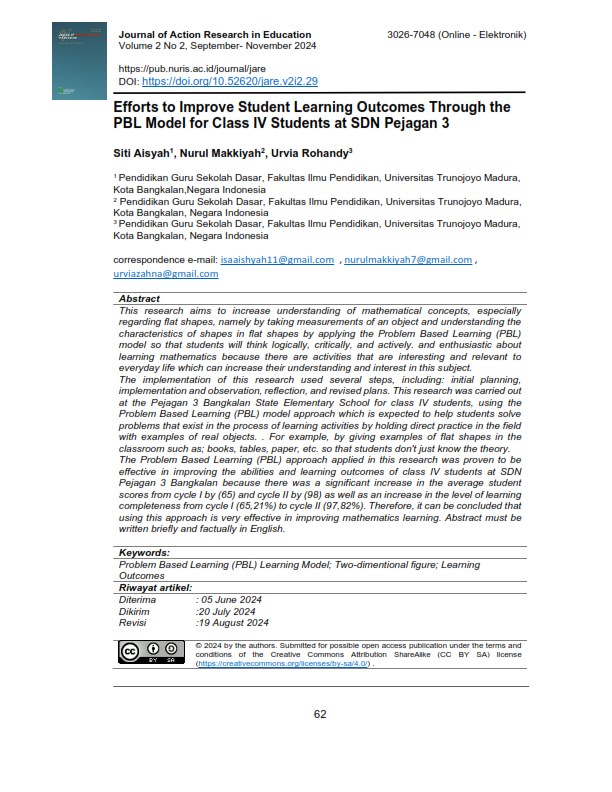Efforts to Improve Student Learning Outcomes Through the PBL Model for Class IV Students at SDN Pejagan 3
DOI:
https://doi.org/10.52620/jare.v2i2.33Keywords:
Problem Based Learning (PBL) Learning Model, Two-dimentional figure, Learning OutcomesAbstract
This research aims to increase understanding of mathematical concepts, especially regarding flat shapes, namely by taking measurements of an object and understanding the characteristics of shapes in flat shapes by applying the Problem Based Learning (PBL) model so that students will think logically, critically, and actively. and enthusiastic about learning mathematics because there are activities that are interesting and relevant to everyday life which can increase their understanding and interest in this subject.
The implementation of this research used several steps, including: initial planning, implementation and observation, reflection, and revised plans. This research was carried out at the Pejagan 3 Bangkalan State Elementary School for class IV students, using the Problem Based Learning (PBL) model approach which is expected to help students solve problems that exist in the process of learning activities by holding direct practice in the field with examples of real objects. . For example, by giving examples of flat shapes in the classroom such as; books, tables, paper, etc. so that students don't just know the theory.
The Problem Based Learning (PBL) approach applied in this research was proven to be effective in improving the abilities and learning outcomes of class IV students at SDN Pejagan 3 Bangkalan because there was a significant increase in the average student scores from cycle I by (65) and cycle II by (98) as well as an increase in the level of learning completeness from cycle I (65,21%) to cycle II (97,82%). Therefore, it can be concluded that using this approach is very effective in improving mathematics learning. Abstract must be written briefly and factually in English.
References
Arikunto, S. (2021). Penelitian Tindakan Kelas: Edisi Revisi. Bumi Aksara.
Azizah, A. (2021). Pentingnya Penelitian Tindakan Kelas Bagi Guru dalam Pembelajaran. Auladuna : Jurnal Prodi Pendidikan Guru Madrasah Ibtidaiyah, 3(1), 15–22. https://doi.org/10.36835/au.v3i1.475
Dr. Rita Rahmaniati, M. P. (2024). MODEL -- MODEL PEMBELAJARAN INOVATIF. Uwais Inspirasi Indonesia.
Dra. Yetti Ariani, M. P., Yullys Helsa, M. P., & Ahmad, S. (2020). Model Pembelajaran Inovatif Untuk Pembelajaran Matematika Di Kelas IV Sekolah Dasar. Deepublish.
Edi, F. R. S. (2016). Teori Wawancara Psikodignostik. Penerbit LeutikaPrio.
Ester Reni Sawitri, S. P. (2023). MODEL DISCOVERY LEARNING BERBANTUAN KOMIK UNTUK MENINGKATKAN MINAT DAN HASIL BELAJAR. Uwais Inspirasi Indonesia.
Fahmi Saifuddin, A., & Tika, A. (2024). PENGARUH MODEL PEMBELAJARAN CONTEXTUAL TEACHING AND LEARNING TERHADAP HASIL BELAJAR MATEMATIKA KELAS IV SDN SENDANGMULYO 02. 10(7), 1686–1694.
Hutauruk, J. B. D. A. J. B. (2018). Buku Ajar Matematika Sekolah SMP. Deepublish.
Isrokatun, I., Hanifah, N., Maulana, M., & Suhaebar, I. (2020). Pembelajaran Matematika dan Sains secara Integratif melalui Situation-Based Learning. UPI Sumedang Press.
Kistian, A. (2018). Pengaruh Model Pembelajaran Contextual Teaching and Learning (CTL) terhadap Hasil Belajar Matematika Siswa Kelas IV SD Negeri Langung Kabupaten Aceh Barat. Bina Gogik, 5(2), 13–24.
Maria, S. (2022). Meningkatkan Hasil Belajar Siswa Pada Materi Bangun Datar Menggunakan Model Contextual Teaching and Learning (Ctl). Kelas Pendidikan Dasar & Menengah, 12(1), 19–26.
Masalah, L. B., & Mandala, J. P. (2022). 2995-9226-1-Pb. 7(1), 104–112.
Masniladevi, M. (2017). Keterampilan Berpikir Kritis Menggunakan Model Contextual Teaching and Learaning Di Sekolah Dasar. Jurnal Inovasi Pendidikan Dan Pembelajaran Sekolah Dasar, 1(2), 87–98. https://doi.org/10.24036/jippsd.v1i2.8617
Paskalia Yasinta, Etriana Meirista, & Abdul Rahman Taufik. (2020). Studi Literatur: Peningkatan Kemampuan Berpikir Kritis Matematis Siswa Melalui Pendekatan Contextual Teaching and Learning (CTL). ASIMTOT : Jurnal Kependidikan Matematika, 2(2), 129–138.
Rahmadani, A., Wandini, R. R., Dewi, A., Zairima, E., & Putri, T. D. (2023). Upaya Meningkatkan Berpikir Kritis dan Mengefektifkan Pendekatan Kontekstual dalam Pembelajaran Matematika. Edu Society: Jurnal Pendidikan, Ilmu Sosial Dan Pengabdian Kepada Masyarakat, 2(1), 427–433. https://doi.org/10.56832/edu.v2i1.167
Setiawan, H. R., Bahtiar, A., & Harfiani, R. (2023). Monograf: Metode Role play (Upaya Peningkatan Motivasi dan Hasil Belajar Peserta Didik). umsu press.
Zulmaulida, R., Saputra, E., Munir, M., Zanthy, L. S., Wahnyuni, M., Irham, M., Akmal, N., & others. (2021). Problematika Pembelajaran Matematika. Yayasan Penerbit Muhammad Zaini.




